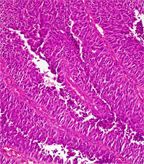Bladder Cancer Recurrence High, Better Follow-Up Care Needed
Recent studies suggest patients with bladder cancer are not receiving optimal care or the follow-up surveillance as recommended by the National Comprehensive Cancer Network (NCCN).
Recent studies suggest patients with bladder cancer are not receiving optimal care or the follow-up surveillance as recommended by the National Comprehensive Cancer Network (NCCN). The question of optimal treatments for subtypes of bladder cancer is difficult to address without understanding the natural history of bladder cancer.

Urothelial carcinoma of the bladder
A population-based study of the natural history of the disease in the United States is now published in the journal Cancer. Karim Chamie, MD, of the department of urology at the David Geffen School of Medicine at the University of California, Los Angeles (UCLA), and colleagues analyzed 7,410 individuals with high-grade non–muscle-invasive disease who were diagnosed between 1992 and 2002. The data came from the Surveillance, Epidemiology, and End Results (SEER)–Medicare database. The patients were followed up until 2007.
The research suggests bladder cancer patients at high risk for recurrence often do not receive effective care or timely follow-up to reduce their risk of progression.
About 72,500 people will be diagnosed with bladder cancer in 2013 and about 15,200 will die of the disease, according to the National Cancer Institute (NCI). Overall, the incidence of bladder cancer is down about 1.3% in the period between 2007 and 2010, compared with the years 1975 to 2006.
However, patients diagnosed with bladder cancer are more likely to have recurrence with or without disease progression.
According to Christopher Saigal, MD, associate professor in the department of urology at UCLA and senior author of the current study, the risk of recurrence has previously been linked with higher tumor grade and stage at diagnosis, the number of tumors at diagnosis, presence of carcinoma in situ in the bladder, and continued patient smoking.
The majority of patients on the study with bladder cancer were under the age of 80 (61.3%), male (75.5%), and white (91%).
Almost three-fourths of the patients with high-grade non–muscle-invasive bladder cancer had a recurrence, progressed, or died within a 10-year period. Approximately 41% of these patients will recur without progression, and an additional 33% will have progressive disease. Among those who progress, the researchers found, 40% will die of their bladder cancer. “The dismal prognosis of non–muscle-invasive bladder cancer progressing to myoinvasive disease highlights the need to intensely survey this high-risk population at an early point,” state the authors.
The 10-year recurrence, progression, and mortality rates due to bladder cancer were 74.3%, 33.3%, and 12.3%, respectively. During the follow-up period, 39% of the patients (2,897) had a recurrence without progression, and 33% (2,449) had disease progression. Of the patients who progressed, 981 died from their bladder cancer.
Factors found to be associated with recurrence and mortality were being female, black, undifferentiated grade, and stage Tis and T1. Age greater than 70 was associated with a statistically significant lower risk of progression compared with those patients under age 70. But, older age was associated with a higher risk of dying of bladder cancer compared with those younger than age 70.
Sex and race did not correlate with recurrence rates, but these factors were significantly associated with progression and bladder cancer mortality rates. Women and black patients had a higher chance of progressing and dying of their bladder cancer compared with men and white patients.
The study also found patients are not receiving enough surveillance cystoscopies, which can find tumors early, prior to progression of invasive disease linked to a higher risk of mortality. “Patients with lower risk can be spared increased cystoscopy rates if the urologist uses a ‘risk stratified’ surveillance approach,” Saigal said.
Further follow-up studies of this large observational study on clinical care and follow-up of bladder cancer patients are needed. Because of the rapid recurrence and progression of bladder cancer, the authors emphasize the need for intense surveillance of high-risk patients, as outlined in both NCCN and American Urological Association (AUA) guidelines.
“This is one of the few areas in oncology where we have strong evidence of a link between process of care-surveillance and adjuvant therapy-and outcomes that matter to patients, such as survival and quality of life,” said Saigal. “We have terrible compliance at the national level, according to SEER-Medicare data. This area would seem an attractive target for performance measurement by Medicare.”